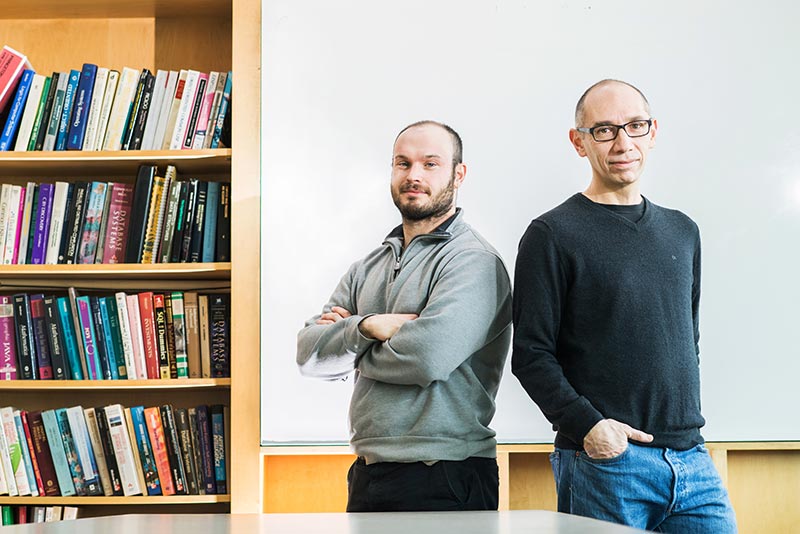A Missing Piece in the Origin of Life Puzzle
Researchers studying the origin of life are in the dark about phosphate. Two BU researchers are now shining a light on the issue.

Josh Goldford (left) and Daniel Segrè are exploring how the earliest biochemistry may have occurred without the important molecule phosphate. Photo by Jackie Ricciardi
In the beginning, there was…well, not much, biologically speaking. The Earth formed around 4.5 billion years ago, and the first single-celled life started around 3.8 billion years ago. In that 700-million-year window, the geochemistry of inanimate rocks, water, and atmosphere somehow coalesced to form the biochemistry that makes all life possible. That’s quite a leap. How it happened remains one of the biggest mysteries in the search for the origin of life—and now, Boston University researchers think that they may have found a piece of the puzzle.
The research, published in the March 9, 2017, cover article of the journal Cell, looks at the role of phosphate in biological systems—or rather, the lack of it. Phosphate, a molecule made up of one central phosphorus atom surrounded by four oxygen atoms, contains bonds that are very good at storing energy. Break those bonds in a cell, and the energy fuels our metabolism. Phosphate also forms the backbone of DNA and supplies energy in the creation of many important biomolecules. Phosphate is, in a word, important.

The problem is, it is also hard for biological systems to find and use. Phosphate is almost always locked away in rocks or chemical bonds that make it very difficult for a biological system to get at, says Daniel Segrè, a bioinformatics researcher at BU, professor in both the BU College of Engineering (ENG) biomedical engineering and College of Arts & Sciences biology departments, and corresponding author of the paper. Even today, phosphorous is the limiting element in many ecosystems, and if life today has a hard time accessing the chemical, maybe pre-life reactions didn’t have it at all. How much, the researchers asked, could pre-life do without phosphate?
To find out, researchers used a simple formula to look at just how many molecules could have been formed using a more limited geochemistry. They used an algorithm, called a network expansion algorithm, that they seeded with particular molecules that likely existed on the early Earth—so, minus phosphate. Then, says Segrè, they asked: “Where can you go from that point?”
Josh Goldford (ENG’18), a bioinformatics PhD student and lead author on the paper, soon found the answer. With just the algorithm and some assumptions about early Earth, Goldford could create a network of 315 chemical reactions forming 260 different molecules, including many important amino acids.
When he saw those results, Goldford brought them to Segrè and co-authors Hyman Hartman, a biologist at MIT, and Temple Smith, a BU professor emeritus of biomedical engineering. “I think they couldn’t really believe it at first,” says Goldford. Phosphate, apparently, may not have been needed to create a shocking number of molecules. The research doesn’t fill in all the blanks between inanimate chemicals and life, but it may explain a very big first step—an early chemical scaffolding that life could later build on, once phosphate came into the picture. And, like scaffolding, these reactions are still hidden within all organisms, like a kind of ancient blueprint, says Goldford.
“If you were to look on Google Maps at Boston, you’d see this very expansive metropolitan area,” says Goldford. “But you’d also see this weird kind of downtown structure that doesn’t really look very grid-like. It looks a little more random. When you are looking at that, you’re not just looking at a map of Boston today; you’re looking at a historical document of what Boston was when it first started….Metabolism is kind of a roadmap of chemical processes, and if you look at the center, you’re looking at a historical document of how metabolism maybe evolved.”
These results have only been found on the computer and still need to be confirmed in the lab. Even then, Goldford expects that these results will be contentious. Researchers who study the origin of life generally fall into two basic groups—those like Segrè, Goldford, Hartman, and Temple, who think that pre-life metabolism began with geochemical reactions that lead to self-sustaining biomolecules, and those who think that it started with RNA replicating and fueling the reactions. Think of it like metabolism-first vs RNA-first.
Goldford expects that there will be some pushback from the RNA-first community, but there may be some pushback from the metabolism-first community as well.
Markus Ralser, a biochemical researcher at the University of Cambridge who was not involved in the research, is also a “metabolism-first” researcher. He wrote in an email that the paper’s results are “most likely correct,” but thinks it’s more likely that there was natural selection for reactions that had minimal phosphate—which could have led to similar results and which the authors note in the paper. Phosphate is just too important a chemical to not include at all.
Ultimately, both Segrè and Goldford say they know that this will not end the debates about the origin of life. Instead, they hope it will fuel more discussion.
“I don’t think there is certainty in this field in any theory or scenario,” says Segrè. “We try to make interesting inferences and see what might have been plausible, but it is very hard to know what exactly happened.”
Comments & Discussion
Boston University moderates comments to facilitate an informed, substantive, civil conversation. Abusive, profane, self-promotional, misleading, incoherent or off-topic comments will be rejected. Moderators are staffed during regular business hours (EST) and can only accept comments written in English. Statistics or facts must include a citation or a link to the citation.